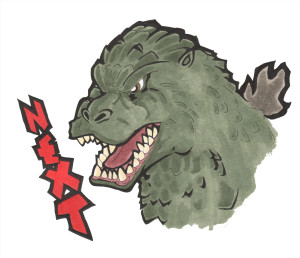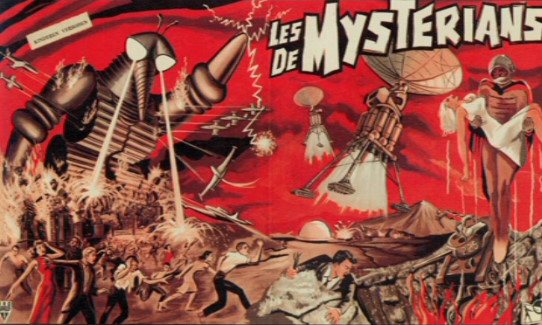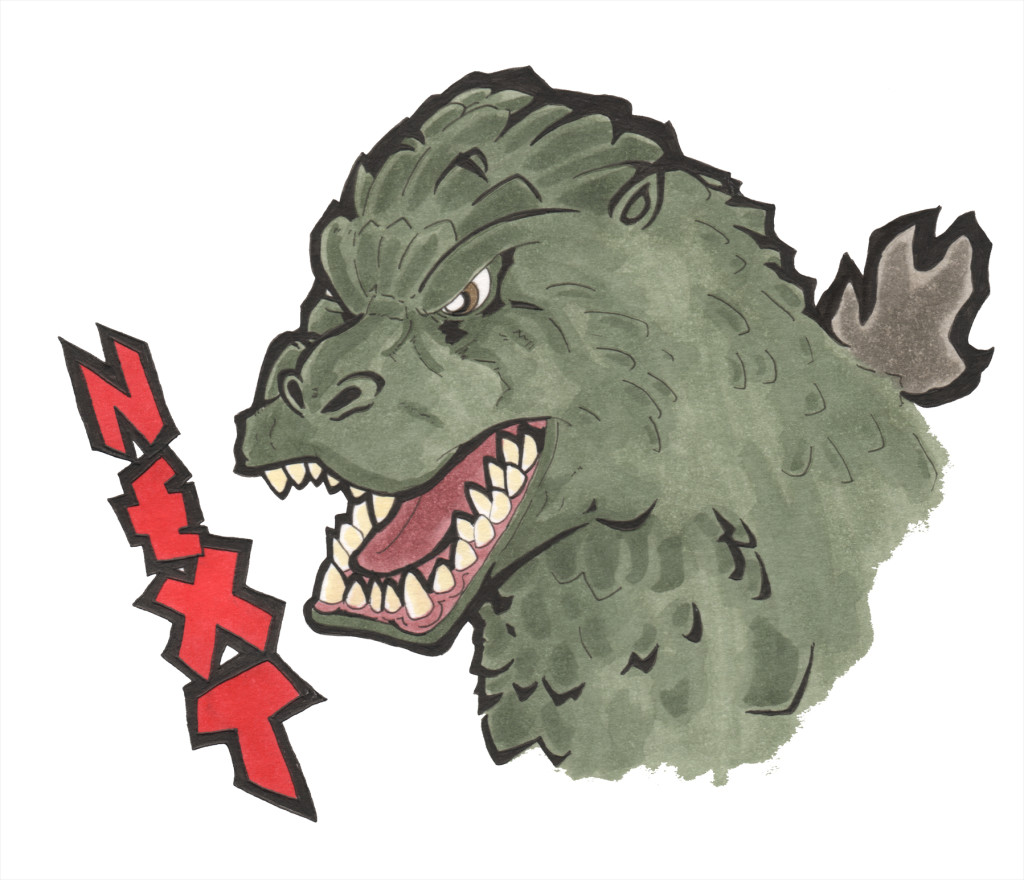Varan The Unbelievable – 1962, Ishiro Honda – Japan

Poor Varan. Turns out Big Papa Toho did not create all his Kaiju equal. Like Godzilla, Rodan, and Mothra, Varan, yet another giant, spikey lizard (but with flying squirrel flaps!), was introduced to the world in his very own standalone movie; and like his three, more fortunate comrades, he got the royal treatment. His name was the title of the movie, he didn’t share the stage with any other monsters, and in his film, he was depicted as being a near invincible force of prehistoric fury which threatened all of Japan, if not the world. This is pretty boiler plate kaiju contract stuff. However; whereas Godzilla, Mothra, and Rodan went on to enjoy decade spanning careers full of glorious mayhem, Varan fast faded into relative obscurity. In fact, the only time I remember seeing him again was in Destroy all Monsters, and even then, he was basically downgraded to the Kaiju equivalent of an extra. he didn’t even fight anybody. Fucking Gorosaurus got more love than Varan! What went wrong?!
THE PLOT~ when two scientists are mysteriously killed in a remote area of Japan while on an expedition to capture butterflies (really!) the brilliant decision to dispatch three additional scientists to the exact same area is made without haste. Lo and behold, our new team of scientists discover that the superstitious locals believe these killings to have been done by their god, who is, no surprise, an angry monster. This primitive belief is instantly belittled and dismissed by our scientists, who go on to immediately awaken, and subsequently irritate the shit out of that very monster, who then destroys the village real hard. Our dickhead scientists then go back to their big, monster-free city and tell everybody about this creature, who they have named Varan, and Japan says “What’s that you say? A living dinosaur? The most miraculous living creature on Earth? We better go kill that.” So, a bunch of Army dudes descend on the rubble that was once a peaceful Japanese village out in the middle of nowhere and try their damndest to kill what is quite possibly the rarest creature on the planet. While they fail to kill Varan at this time, they are succesful in pissing him off- wildly succesful, in fact. Varan, no longer enjoying his living situation now that the lake he slept in is poisoned and cannon shells seem to be impacting against his head constantly, gets the hell out of there and travels to Tokyo for absolutely no reason. The Japanese, refusing to take “Please don’t kill me” for an answer, assemble their top scientists for Plan B- the focus of which is still killing the hell out of Varan because he is very large and not shaped like a person- a crime they cannot pardon. A new plan is formulated and put into effect, and Varan suffers. Victory!
So, just why exactly did Gojira, Mothra, and Rodan go off with such a glorious bang, while Varan goes off with a muted, humiliated frump? Well…
Varan feels cheap, for one thing- low budget, and crummy. firstly, there were apparently more than one Varan costumes used, and they are of inconsistent quality. That’s a problem, but it’s far from the only area where the producers seemed a little penny-conscious; the underwater sequences are especially flimsy and look devastatingly swimming-pool-like. I don’t think this is what killed the film, however. Budgetary shortcomings can be overlooked, and monsters can be embraced even if they begin their lives as poorhouse kaiju. For Varan, his movie suffers greatly from its simplicity more than anything. It feels underdeveloped and rushed, right off the bat, it’s evident that this is a much more linear, Point A to Point B style monster movie than Gojira, Mothra, or Rodan were. This is 100% the truth, and it sucks.
It’s just so one dimensional! It never really takes the time to breathe or invest in its characters. Every time Varan goes on a rampage the tension is actually actively removed by frequent visits over to the sidelines, where numerous onlookers, mostly scientists, reporters, and military personnel, just hang out and watch the chaos, apparently not at risk of getting Varraned. To be frank, this is a bone-headed mistake, it makes this monster mayhem feel alarmingly safe, and in the end the black and white photography does more to make Varan feel gloomy than the actual on-screen smashing.
Varan’s simplicity is, however, most devastating in it’s tendency to dole out the what, while totally skipping over the why. That’s the greatest folly of Varan; gone entirely from it’s composition is the element of introspection which we had come to take for granted in Toho’s monster films. This thing could have carried the alternative title “SCIENTISTS ARE DICKS: THE MOVIE.” That’s the real moral, and it’s a moral that appears to be lost on Varan’s narrative altogether. This movie totally glosses over the undeniable guilt of the film’s scientists, who are responsible for everything bad that happens in this film, start to finish. It’s not ever even suggested that they could be guilty of anything whatsoever, and damn, they’re super, super guilty, in a big way. I wanna take you through a scene:
When the second group arrives at the remote village near Varan’s den, the same village that is soon after destroyed by Varan, there is a conflict of sorts between the town’s religious leader and Kenji, the lead scientist who has come to investigate what has happened to his colleagues. Essentially; it plays out like this:
Kenji: ‘Sup? Heard you guys think there’s a monster. That’s so stupid- there isn’t!
Priest: …Well, we’re pretty sure there is-
Kenji: That’s stupid!
Priest:…Well, okay, just listen, please, don’t go over there into that area you guys, okay? It’s kind of a big deal for us-
Kenji: PISS ON YOUR RELIGION, WE’RE SCIENTISTS! WE’RE GOING RIGHT INTO THAT AREA, YOU STUPID IDIOT!!!
<Barges in, instantly piss off monster>
Kenji: Oh, looks like he is real.
<monster completely destroys village and everything inside it>
Kenji: Well, we’re going back to Tokyo where we have electricity and McDonalds, have fun dying in the wilderness without food or shelter, you fucking assholes.
AND SCENE!
For real, that’s the bare bones of how that plays out. These people show up, immediately disrespect the locals, blatantly defy their rules, they heed no warnings because they think they know better, and then when they wake up Varan, they just bounce, and the only people left to bare the weight of the consequences are the poor villagers, who are first treated like idiots and then go on to lose absolutely everything, insult AND injury. The fate of these people is never again addressed or considered, and no amount of shame is directed at the scientists who actually provoked the attack in the first place. They appear to forget about these human lives that they’ve destroyed immediately, and move onto the task killing this creature for no reason at all. It’s this attack that drives Varan out of his ultra-remote home and into highly a populated metropolitan area, as well, so it’s actually so, so obvious that this is another hubris story, but I honestly think the film fails to recognize this. It’s never explored or stated, they really just follow it along in a startlingly two dimensional fashion, and I think this is the biggest reason Varan failed to gain traction, and ultimately, could not help establish Varan himself as a monster with a future in the film industry. This is the Toho picture that rushed out a statement before it even knew what that statement was; and it’s not even a new statement. In fact, it’s so overt, that the argument could be made that this isn’t even hubris, so much as a simple lesson in morality. “Don’t be a dick” is another moral very present in Varan, but it too is not acknowledged or expressed in a conscious way by the movie itself. It’s kinda nuts.
This is a real minimalist, cut and dry monster movie that fails to give us a reason to feel anything about what we experience within it’s narrative. Frankly, it’s bellow average. Varan suffers from terminal simplicity, and because of this, his future is a bleak, bleak thing. It’s too bad, he seems like an okay guy.
C-





 He is the doofus of the kaiju world.
He is the doofus of the kaiju world.





 “Hey, Japan- your country looks really great!… FOR ME TO POOP ON!”
“Hey, Japan- your country looks really great!… FOR ME TO POOP ON!” 